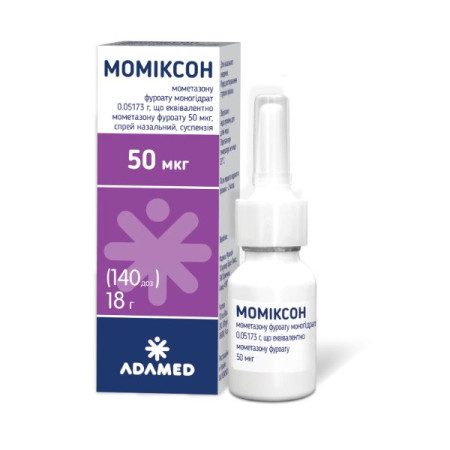Edema film-coated tablets 5 mg blister No. 30

Instructions for use Edem film-coated tablets 5 mg blister No. 30
Composition
active ingredient: desloratadine;
1 tablet contains desloratadine, calculated as 100% anhydrous substance, 5 mg;
excipients: calcium hydrogen phosphate dihydrate, microcrystalline cellulose, lactose monohydrate, corn starch, hypromellose, calcium stearate, Opadry II 85F 30571 Blue (iron oxide red (E 172), polyvinyl alcohol, titanium dioxide (E 171), talc, indigo carmine (E 132), polyethylene glycol).
Dosage form
Film-coated tablets.
Main physicochemical properties: round tablets with a biconvex surface, coated with a blue shell.
Pharmacotherapeutic group
Antihistamines for systemic use.
ATX code R06A X27.
Pharmacological properties
Pharmacodynamics
Desloratadine is a long-acting, non-sedating antihistamine that selectively antagonizes peripheral H1 receptors. After oral administration, desloratadine selectively blocks peripheral histamine H1 receptors.
In vitro studies have shown that desloratadine has anti-allergic and anti-inflammatory properties on endothelial cells. This was demonstrated by the inhibition of the release of pro-inflammatory cytokines such as IL-4, IL-6, IL-8 and IL-13 from human mast cells/basophils, as well as the inhibition of the expression of adhesion molecules such as P-selectin. The clinical relevance of these observations remains to be confirmed.
In high-dose clinical studies in which desloratadine was administered daily at a dose of up to 20 mg for 14 days, no statistically significant changes in the cardiovascular system were observed. In a clinical pharmacology study, when using 45 mg per day (10 times the maximum daily clinical dose) for 10 days, no prolongation of the QT interval was observed.
In patients with allergic rhinitis, Edem® effectively relieved symptoms such as sneezing, nasal discharge and itching, as well as eye irritation, tearing and redness, and itching of the palate. The drug effectively controlled symptoms for 24 hours.
Desloratadine has little or no penetration into the central nervous system. In controlled clinical trials, the incidence of somnolence at the recommended dose of 5 mg/day was not different from that of placebo. In clinical trials, a single dose of desloratadine at a daily dose of 7.5 mg did not affect psychomotor performance.
The drug effectively alleviates the severity of seasonal allergic rhinitis, taking into account the total score of the rhinoconjunctivitis quality of life questionnaire. The maximum improvement was noted in the questionnaire items related to practical problems and daily activities that limited symptoms.
Chronic idiopathic urticaria has been studied in a clinical model of urticaria conditions. Since histamine release is a causal factor in all forms of urticaria, desloratadine is expected to be effective in relieving symptoms in forms of urticaria other than chronic idiopathic urticaria.
In two placebo-controlled 6-week studies in patients with chronic idiopathic urticaria, desloratadine was effective in relieving pruritus and reducing the number and size of hives by the end of the first dosing interval. In each study, the effect was maintained throughout the 24-hour dosing interval. Itch relief of more than 50% was observed in 55% of patients taking desloratadine compared with 19% of patients taking placebo. The drug has no significant effect on sleep and daytime activity.
Pharmacokinetics
Absorption.
Desloratadine plasma concentrations can be determined 30 minutes after administration. Desloratadine is well absorbed, with peak concentrations occurring approximately 3 hours after dosing; the elimination half-life is approximately 27 hours. The extent of desloratadine accumulation was consistent with its elimination half-life (approximately 27 hours) and dosing frequency (once daily). The bioavailability of desloratadine was dose-proportional over the range of 5 to 20 mg.
In a pharmacokinetic study in which the demographics of the patients were comparable to the general population of patients with seasonal allergic rhinitis, 4% of the participants had higher concentrations of desloratadine. This number may vary depending on ethnicity. The maximum concentration of desloratadine was approximately 3-fold higher after approximately 7 hours, and the terminal half-life was approximately 89 hours. The safety profile of these patients did not differ from that of the general population.
Distribution.
Desloratadine is moderately bound to plasma proteins (83-87%). When desloratadine doses (5 to 20 mg) are administered once daily for 14 days, there is no evidence of clinically significant drug accumulation.
Biotransformation.
The enzyme responsible for the metabolism of desloratadine has not yet been identified, so some interactions with other drugs cannot be completely excluded. Desloratadine does not inhibit CYP3A4 in vivo; in vitro studies have shown that the drug does not inhibit CYP2D6, a substrate or inhibitor of P-glycoprotein.
In a single-dose study of desloratadine 7.5 mg, food intake (a high-fat, high-calorie breakfast) did not affect the pharmacokinetics of desloratadine. Grapefruit juice was also found to have no effect on the pharmacokinetics of desloratadine.
Indication
Elimination of symptoms associated with:
allergic rhinitis (see section "Pharmacological properties");
urticaria (see section "Pharmacological properties").
Contraindication
Hypersensitivity to the active substance or to any of the excipients of the drug or to loratadine.
Interaction with other medicinal products and other types of interactions
In clinical studies of desloratadine tablets, no clinically significant interactions were observed with concomitant use of erythromycin or ketoconazole.
According to clinical and pharmacological studies, when the drug was used together with alcohol, no increase in the negative effect of ethanol on psychomotor function was noted. However, in the post-registration period, cases of alcohol intolerance and alcohol intoxication were observed during the use of the drug. Therefore, caution should be exercised when drinking alcohol during treatment with Edem®.
Application features
In patients with severe renal failure, Edem® should be administered under the supervision of a physician.
Desloratadine should be used with caution in patients with a history of seizures or a hereditary predisposition. In patients who experience a seizure during treatment, consideration should be given to discontinuing desloratadine.
Patients with rare hereditary problems of galactose intolerance, the Lapp lactase deficiency or glucose-galactose malabsorption should not take this medicine.
Use during pregnancy or breastfeeding
Desloratadine did not demonstrate teratogenicity in animal studies.
The safety of the drug during pregnancy has not been established, therefore the use of Edem® during this period is not recommended.
Breastfeeding period.
Desloratadine passes into breast milk, therefore the use of Edem® in breastfeeding women is not recommended.
Ability to influence reaction speed when driving vehicles or other mechanisms
Desloratadine has not been shown to affect the ability to drive or use machines. However, patients should be advised that very rarely some people experience drowsiness, which may affect their ability to drive or use machines.
Method of administration and doses
Adults and children over 12 years of age: 1 tablet once daily, with or without food, for the relief of symptoms associated with allergic rhinitis (including intermittent and persistent allergic rhinitis) and urticaria.
Treatment of intermittent allergic rhinitis (presence of symptoms less than 4 days per week or less than 4 weeks) should be carried out taking into account the anamnesis: stop after the symptoms disappear and resume after their reappearance.
In case of persistent allergic rhinitis (presence of symptoms more than 4 days a week or more than 4 weeks), treatment should be continued throughout the entire period of contact with the allergen.
Children
The efficacy and safety of Edem® tablets in children under 12 years of age have not been established.
Overdose
In case of overdose, standard measures should be taken to remove unabsorbed active substance. Symptomatic and supportive treatment is recommended. In clinical studies in which desloratadine was administered at doses of 45 mg (9 times the recommended dose), no clinically significant adverse reactions were observed. Desloratadine is not removed by hemodialysis. Its removal by peritoneal dialysis has not been established.
Side effects
In clinical trials for indications including allergic rhinitis and chronic idiopathic urticaria, adverse events were reported 3% more frequently in patients receiving 5 mg daily than in patients receiving placebo.
The most commonly reported side effects compared to placebo were fatigue (1.2%), dry mouth (0.8%), and headache (0.6%).
Children: In clinical trials involving 578 adolescents aged 12 to 17 years, the most common adverse reaction was headache, occurring in 5.9% of patients receiving desloratadine and 6.9% of patients receiving placebo.
There is a risk of psychomotor hyperactivity (abnormal behavior) associated with the use of desloratadine (which may manifest as anger and aggression, as well as agitation).
Summary table of adverse reaction frequencies.
The frequency of adverse reactions is classified as follows: very common (≥1/10), common (≥1/100, <1/10), uncommon (≥1/1000, <1/100), rare (≥1/10000, <1/1000), very rare (<1/10000), frequency unknown (cannot be estimated from the available data).
| Organ classes/systems | Frequency of occurrence | Adverse reactions |
| From the psyche | very rarely | hallucinations |
| frequency unknown | depressed mood | |
| From the nervous system | headache | |
| very rarely | dizziness, drowsiness, insomnia, psychomotor hyperactivity, convulsions | |
| From the heart | very rarely | tachycardia, rapid heartbeat |
| frequency unknown | QT prolongation, supraventricular tachyarrhythmia | |
| Gastrointestinal tract | often | dry mouth |
| very rarely | abdominal pain, nausea, vomiting, dyspepsia, diarrhea | |
| Hepatobiliary system | very rarely | increased liver enzymes, increased bilirubin, hepatitis |
| frequency unknown | jaundice | |
| Musculoskeletal and connective tissue disorders | very rarely | myalgia |
| Skin and subcutaneous tissue disorders | frequency unknown | photosensitivity |
| From the organs of vision | frequency unknown | dry eyes |
| General violations | often | increased fatigue |
| very rarely | hypersensitivity reactions (including anaphylaxis, angioedema, shortness of breath, itching, rash and urticaria) | |
| frequency unknown | asthenia |
In the post-marketing period, the following events were observed (frequency unknown): QT prolongation, arrhythmia and bradycardia.
Expiration date
3 years.
Do not use the drug after the expiration date indicated on the package.
Storage conditions
Store in the original packaging at a temperature not exceeding 25 °C.
Keep out of reach of children.
Packaging
10 or 30 tablets in a blister. 1 blister in a pack.
Vacation category
Without a prescription.
Producer
JSC "Farmak".
Address
Ukraine, 04080, Kyiv, Kyrylivska St., 74.
There are no reviews for this product.
There are no reviews for this product, be the first to leave your review.
No questions about this product, be the first and ask your question.













